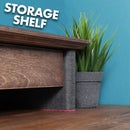Introduction: Perspex Globe Money Box
Look after the pennies and they'll look after you. At least that's what we hope. Either way, having a money box is a great way to save money. Especially when you can see those savings grow with a clear perspex money box! In this post I'll show you how to make one.
Tools Used:
- Laser Cutter (not needed)
- Bandsaw
- Drill & Driver
- Scissors
Materials Used:
- Project Pack
- 18mm Plywood (your choice of filler material)
- Clear Perspex
- Screws
- Felt Baize
- Self Adhesive Paper
- Spray Adhesive
- Spray Lacquer
- Sand Paper
Step 1: Make the Perspex Pieces
We'll start this project with the perspex pieces. Now I used a laser cutter to etch and cut out my pieces. You don't need a laser though. I have a video you can watch HERE that shows how you can etch/engrave perspex with just a small rotary tool by hand. Another option would be to purchase the Project Pack for this project HERE. It includes custom perspex pieces, screws, felt baize, self adhesive template and step by step instructions.
To keep the exterior of the perspex smooth I opted to mirror the image and etch the inside of the perspex instead. This way, the image looks correct when viewed from the other side. I also etched points for where to drill holes later. The back piece is cut exactly the same just without any decorative etching.
With those both cut, I could head to the drill press and drill where I etched marks using a 3.5mm drill bit. After drilling the holes, I counter sunk them with a counter sink bit making sure the heads of the screws sat below the surface.
Step 2: Make the Filler Piece
That's the perspex pieces done, now onto the filler piece. This could be any rigid material you like. I opted to use plywood as I really like the look of exposed plywood edges. I glued up a square block slightly larger than the perspex pieces. I went with three layers of 18mm plywood. You can of course make the filler piece as thick as you like. The thicker the piece the more space inside the money box.
I printed this template onto some self adhesive paper. This will act as my cutting guide. With the glue dry I could add the self adhesive template to the block and cut it out at the bandsaw. A bandsaw is really the best tool for this operation but you could also use a scroll saw, a jigsaw or even a coping saw by hand.
After sanding I decided to paint the faces of the plywood black just to make it look neater. It then got 3 coats of spray lacquer. I didn't apply finish to the base of the filler piece so the felt baize will adhere better.
With a slightly oversized piece of felt baize cut, I sprayed it with spray adhesive and applied it to the base. Once it was dry I trimmed it flush with a scissors.
Step 3: Put It Together
Now its time to fit the perspex pieces. It's as simple as laying them onto the filler piece, marking where the holes fall and drilling a pilot hole with the 3.5mm bit. I did this with a hand drill but it could be done at the drill press too.
With the holes drilled its just a case of adding screws and the money box is complete. I really hope you like how this turned out, there are lots of design options you can go with. I hope you give it a go for yourself.




